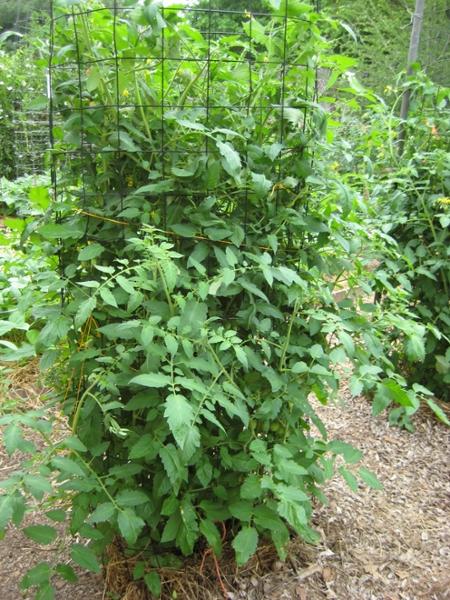 Spring is the season of the vertical vegetable garden. Trellises and cages are our
friends, for they allow us to have much more production by growing up rather than
horizontally.
Spring is the season of the vertical vegetable garden. Trellises and cages are our
friends, for they allow us to have much more production by growing up rather than
horizontally.
Any plant can lay on the ground and be somewhat productive, but some plants on the ground expose themselves to fruit rot, disease and bug predation. For instance, cucumber vines could lay on the ground, and in most farming situations, they do. But in back yard gardens and small farms, cucumbers can be grown up a trellis, which will allow better airflow through the leaves thus preventing disease; and fruit will be held off the ground away from bug predators and rot. Similarly, musk melons (including cantaloupe) and small watermelons can also be grown on trellises, thus using less garden space and enjoying the same benefits of cucumbers being grown off the ground.
Instead of growing bush beans, which take up a lot of horizontal space and have issues with diseases caused by too much moisture, pole beans could be grown on trellises, with vines spaced properly to have good air movement to dry the leaves. A side benefit is that pole beans can be harvested standing up, rather than stooping.
Tomatoes, peppers and eggplants can be caged to hold their long vines and stems/trunks off the ground. In this way, more plants can be grown in the available space, disease issues will be less prevalent, and harvesting will be much easier.
Making use of trellises and cages has the additional benefit of leaving enough garden space to grow more vegetables. For instance, while pole beans are grown along the long edge of a bed, on a trellis that is placed about one foot into the bed, the rest of the bed can be used to grow edamame, black-eyed peas, crowder peas or even some bush beans. Where cucumbers are also grown on a trellis one foot into the side of a bed, butternut squash can be grown in the rest of the bed.
There are a couple of issues to deal with, when melons are grown on a trellis. As the melons start to gain weight, they need to be supported in order to not drop off the vine too early or even when they are ripe, for they can split upon impact. We use the legs of old or inexpensively purchased panty hoses, with the melon inside a leg at the foot of the panty hose, and the other end of the hose tied to the trellis.
There are other spring and summer vegetables that need to be grown on trellises, such as long beans, bitter melon and Malabar spinach.
Many types of trellises can be created, from using bamboo and twine, to purchasing welded wire fencing or concrete remesh sheets that are 7 feet long and 3 feet wide. We stack them two tiers high, connected by wire, and held up by metal t-stakes pounded into the ground about 12 inches or more. For tomato cages, we use the concrete remesh pulled together to form a cylinder, tied together with wire, and stacked two tiers high. We use the same for peppers and eggplants, but just one tier high. The holes in the remesh are 6 inches square, which allows for picking into and through the trellis.
Think about supporting your spring plants on trellises and cages, and enjoy the added harvests, less disease, and easier picking.
This article is provided by Urban Harvest, Inc. To learn about gardening classes, farmers markets, school and community gardens and more go to www.urbanharvest.org or call 713-880-5540 for more information. The article was written by Ray Sher, who is a gardening and permaculture instructor, vegetable and fruit garden consultant, and works his large intensive home vegetable, fruit and herb garden using organic methods. You may contact him at RayInTheGarden@gmail.com.